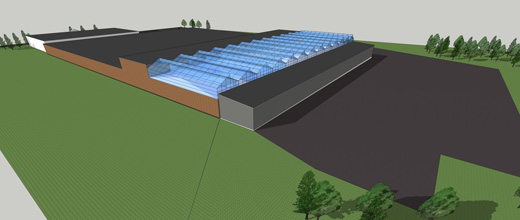You want to do the right thing. Eat locally and sustainably 12 months of the year. Easy enough in California, but you live in Vermont or Minnesota or even New York -- where winter settles in early and leaves late.
As currently deployed, New York State's 36,000 farms can supply perhaps 40% of local food needs, so unless all New York residents become victory gardeners overnight, we will continue to depend on food imported from thousands of miles away.
But what if you started putting farms in new and unexpected areas closer to home? Areas with plenty of sunlight. Look up. Think green roofs.
Building owners motivated to lower HVAC costs, speed building approvals, and lower construction costs are turning to green roofs. But the roofs -- while they provide significant business, health, environmental, and aesthetic benefits -- are not always farms. They could be. They should be.

Welcome to Farms in the Sky
At investor conference Agriculture 2.0, I met Bob Fireman, a long-time real estate executive, who is now the president of Sky Vegetables. Bob dreams big. His vision is to have rooftop greenhouses raising vegetables 12 months of the year in communities from the Bronx to Boston, from the Bay Area to Detroit.
In the process, Sky Vegetables creates jobs and reduces the distance food has to travel -- from a thousand miles to as little as five hundred feet, if you pick up your produce in the parking lot of one of his sky top farms. "Our goal," said Fireman, "is for food to be harvested and consumed within forty-eight hours."
The typical old-line factory or warehouse roof is strong enough for cultivation. In Brooklyn, former e*Trade marketing manager Ben Flanner and New York Botanical Garden educational director Annie Novak started a farm on the roof of a former bagel factory.
Fireman favors standard-issue hydroponic technology. One example, a 44,000-square-foot project slated for the roof of a former shoe factory in struggling Brockton MA, would raise both plants and incomes.
Fifty workers would build the hydroponic farm; 20 full-time staffers and 10 part-timers would manage it once it is operational. Fireman estimates the one-acre garden can produce 300-400 tons of produce a year, "five to fifteen times the yield of conventional farming with only five percent of the water."
While he declined to say what that produce would be worth, I'd calculate that, at $1.00 per pound for organic greens, that's the equivalent of $600,00 to $800,000 per year. Fireman wants to supply local schools and hospitals with "greens and beans that you can't get fresh twelve months of the year." The balance will go to food banks and farmers markets.
Funding Should Be No Problem. Right?
Fireman is focusing on Brockton as a "gateway city looking for jobs and fresh food." Once known as Shoe City USA, Brockton now wants to be a leader in sustainable growth. Support and funding will come from the State of Massachussets, block grants, tax incentives and development credits.
One would expect that -- between the USDA's newfound focus on local production and the Administration's goal of creating new jobs -- Fireman would be overwhelmed with funding options.
The reality is a bit different.
"Stimulus money," according to Fireman, "tends to go shovel-ready projects." 'Shovel-ready' means planning and approvals are done and people could be put to work immediately (generally interpreted as 'within 90 days'). The focus has been on speed. By comparison, rooftop farming may take a bit more time to plan, but it still offers powerful long-term investment value.
To its credit, the USDA is focusing on local food production and specialty crops (aka vegetables) for the first time in a very long time. Secretary Vilsack even started a garden on the grounds of his Washington, D.C. headquarters. But projects they traditionally fund tend to be more focused on rural than urban sites.
"As many champions as we get from the municipal, state and federal levels," Fireman says, "we still have to fight for funding."
While he allows that "we're not going to put California out of business," Fireman is clear that the regional food system has to change. Will rooftop gardens and farms solve all our food production challenges? No more than wind power will replace our near-term dependence on oil. But there has never been a better time to make an investment in our future.
To learn more about food and farming visit Friend of the Farmer